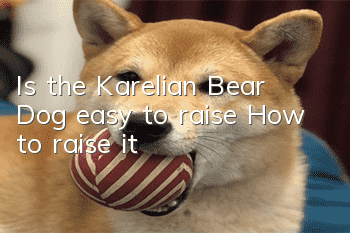Is the Karelian Bear Dog easy to raise? How to raise it?

The Karelian Bear Dog, also called the Kagaran Kahugolian Dog, was produced in Finland in the 17th century. This dog is a typical working dog. Their claws are very sharp, their body structure is rough, and they are very energetic, but they are also It is docile and obedient, easy to train, suitable for hunting large animals, or kept as a companion dog.
1. Appearance characteristics of the Karelian Bear Dog
The average height of the Karelian Bear Dog is 48-58 cm, the average weight is 20-23 kg, and the head is wedge-shaped. There are white markings on the face. The ears are small and covered with dense, warm fur. The small eyes are focused. Black nose. Strong jaw. The chest muscles are strong and the toes are round and thick. The tail is curled back and upward into the arc shape of a typical plush dog, with long hair and white stripes at the end of the tail, which is very popular. There are also truncated ones.
2. Characteristics of the Karelian Bear Dog
The Karelian Bear Dog is a strong, sharp-pawed, energetic dog that is willing to participate in the hunting of any animal. Like the Russian European Laika, this breed has obvious black and white fur, which is different from the northern plush dogs. Brave and strong, independent and stable, wary and indifferent to strangers, and with a keen sense of smell, it is an ideal guard dog and an excellent guard dog.
3. How to raise Karelian Bear Dogs
To ensure the healthy growth of dogs, sufficient nutrients must be provided. Pay attention to the supplement of vitamins and trace elements during daily feeding. Regular and quantitative feeding is not only conducive to cultivating good dog habits, but also is more conducive to the growth and development of dogs. Climate change also has a great impact on dogs' eating, so the amount of food and feeding time should be adjusted appropriately with the seasons; when the climate is hot, feeding should be done in the cool morning and evening. Feed changes should not be too sudden or too frequent.
Guess you like it
Polish dingo | Spinone | Anatolian Shepherd | Australian Shepherd
Hokkaido Dog | Egyptian Greyhound | English Springer Spaniel | Soft-coated Wheaten Terrier | Large Pharaoh Hound
Spanish Mastiff | European Russian Laika | Brazilian Filer | Vizsla | Istrian Shepherd
Teacup Dog | Grimace Mastiff King | Chinese Kunlun Mountain Dog | Griffin Hunting Dog | Beagle Hound
- How to make your dog like to eat dog food Four ways to make your dog fall in love with dog food
- How to protect your dog’s food? Teach you tips on training your dog
- What should I do if my dog has lupus? Immune system diseases should not be underestimated
- If your dog's hair is cut and the skin is cut, the flesh is exposed. If the dog's hair is accidentally cut and the skin is cut, it must be disinfected immediately.
- Do dogs need deworming in summer? What should you pay attention to when raising dogs in summer?
- What to do if your dog has indigestion? Dog indigestion is no small matter!
- What should you pay attention to when vaccinating your dog? What should you pay attention to when vaccinating your dog?
- Symptoms of Rheumatism in Dogs What conditions can cause rheumatism in dogs?
- What to do if dogs fight at home? The owner is the best mediator
- What are the reasons why dogs are obese? Do you know these four reasons?



